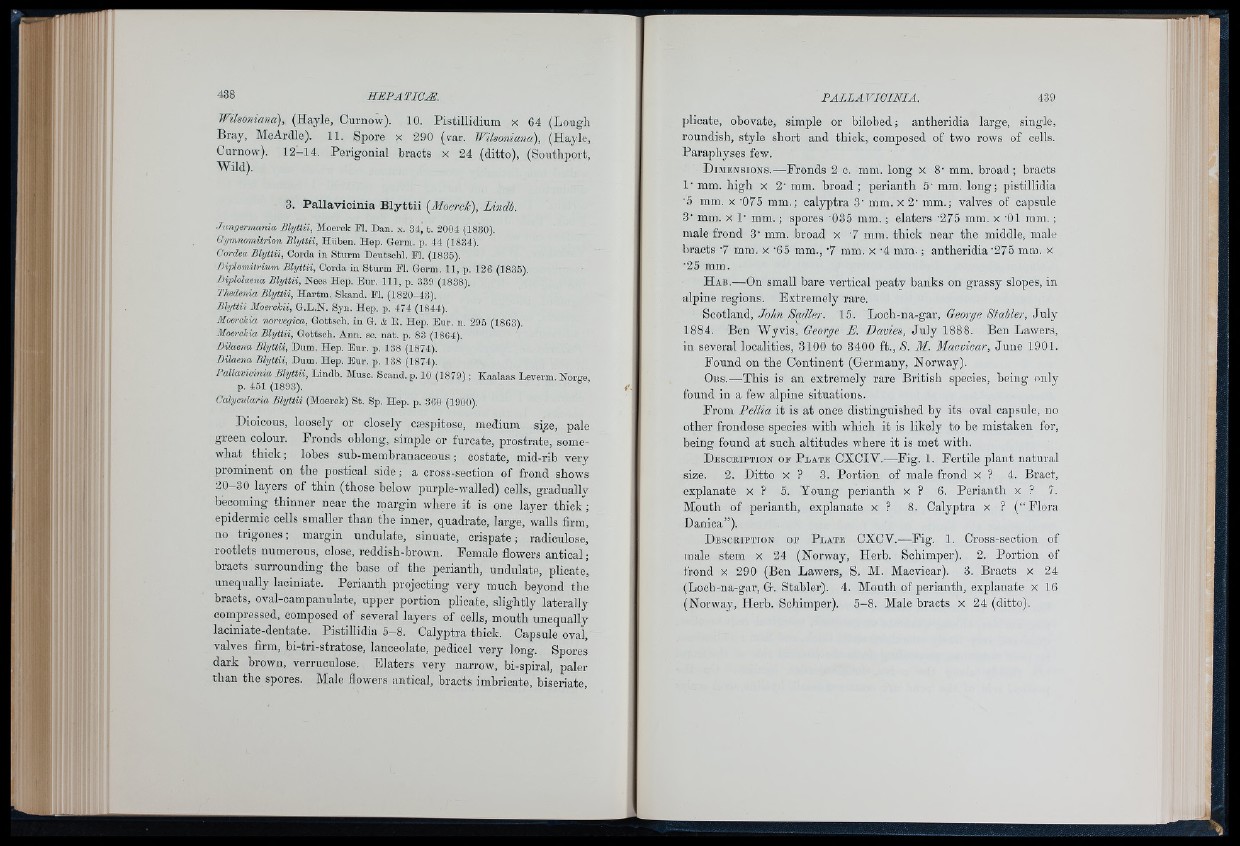
ìFilsoniana), (Hayle, Curnow). 10. Pistillidium x 64 (Lough
Bray, McArdle). 11. Spore x 290 (var. Wilsoniana), (Hayle,
Curnow). 12-14. Perigonial bracts x 24 (ditto), (Southport,
Wild).
3. Pallavicinia B ly ttii {Moerck), Lindh.
■hmgermania Blyttii, Moerck Pl. Dan. x. 34, t. 2004 (1830).
(:ymnomitrion Blyttii, Hüben. Hep. Germ. p. 44 (1884).
Cordea Blyttii, Corda in Sturm Deutschl. Fl. (1835).
liiplomitrium Blyttii, Corda in Sturm Fl. Germ. 11, p. 126 (1835).
Diplolaena Blyttii, Nees Hep. Eur. 111, p. 339 (1838).
Tliedenia Blyttii, H a rtm . Skand. Fl. (1820-43).
B ly ttii Moerckii, G.L.N. Syn. Hep. p. 474 (1844).
Moerckia norvegica, Gottsch. in G. & E. Hep. Eu r. n. 295 (1863).
Moerckia Blyttii, Gottsch. Ann. sc. nat. p. 83 (1864).
Dilaena Blyttii, Dum. Hep. Eu r. p. 188 (1874).
Dilaena Blyttii, Dum. Hep. Bur. p. 138 (1874).
Pallavicinia Blyttii, Lindb. Muse. Scand. p. 10 (1879) ; Kaalaas Leverm. Norge
p. 451 (1898).
Calycularia B ly ttii (Moerck) St. Sp. Hep. p. 360 (1900).
Dioicous, loosely or closely cæspitose, medium size, pale
green colour. Pronds oblong, simple or furcate, prostrate, somewhat
thick ; lobes sub-membranaceous ; costate, mid-rib very
prominent on the postical side ; a cross-section of frond shows
20-30 layers of thin (those below purple-walled) cells, gradually
becoming thinner near the margin where it is one layer thick";
epidermic cells smaller than tlie inner, quadrate, large, walls firm!
no trigones; margin undulate, sinuate, crispate ; radiculose,
rootlets numerous, close, reddish-brown. Female flowers antical ;
bracts surrounding the base of the perianth, undulate, plicate!
unequally laciniate. Perianth projecting very much beyond the
bracts, oval-campanulate, upper portion plicate, slightly laterally
compressed, composed of several layers of cells, mouth unequally
laoiniate-dentate. Pistillidia 5-8. Calyptra thick. Capsule oval,
valves firm, bi-tri-stratose, lanceolate, pedicel very long. Spores
dark brown, verruculose. Elaters very narrow, bi-spiral, paler
than the spores. Male flowers antica], bracts imbricate, biseriate,
plicate, obovate, simple or bilobed; antheridia large, single,
roundish, style short and thick, composed of two rows of cells.
Paraphyses few.
D im e n s io n s .— F ro n d s 2 c. mm . lo n g x 8‘ mm . b ro a d ; b ra c ts
1 ' m m . h ig h x 2' mm . b ro a d ; p e r ia n th 5' m m . lo n g ; p is tillid ia
'5 m m . X '075 ram .; c a ly p tr a 3' m m . x 2' m m .; v a lv e s o f c ap su le
3 ’ mm. X 1’ m m . ; sp o re s '035 m m . ; e la te r s '275 m m . x '01 ram. ;
m a le f ro n d 3' m m . b ro a d x '7 m m . th i c k n e a r th e m id d le , m a le
b r a c ts '7 m m . x '65 m m ., '7 mm . x '4 m m . ; a n th e r id ia '275 mm . x
•25 m m .
H a b .— On small bare vertical peaty banks on grassy slopes, in
alpine regions. Extremely rare.
Scotland, John Sadler. 15. Loch-na-gar, George Stahler, July
1884. Ben Wyvis, George E. Davies, July 1888. Ben Lawers,
in several localities, 3100 to 3400 ft., S. M. Macvicar, June 1901.
Found on the Continent (Cermany, Norway).
O b s .—This is an extremely rare British sjrecies, being only
found in a few alpine situations.
From Pellia it is at once distinguished by its oval capsule, no
other frondose species with which it is likely to be mistaken for,
being found at such altitudes where it is met with.
D escription oe P l .ate CXCIV.—Fig. 1. Fertile plant natural
size. 2. Ditto x ? 3. Portion of male frond x ? 4. Bract,
explánate x ? 5. Toung perianth x ? 6. Perianth x ? 7.
Mouth of perianth, explánate x ? 8. Calyptra x ? (“ Flora
Danioa”).
D escription oe P late CXCV.—Fig. 1. Cross-seotion of
male stem x 24 (Norway, Herb. Schimper). 2. Portion of
frond x 290 (Ben Lawers, S. M. Macvicar). 3. Braots x 24
(Looh-na-gar, G. Stabler). 4. Mouth of perianth, explánate x 16
(Norway, Herb. Schimper). 5-8. Male bracts x 24 (ditto).